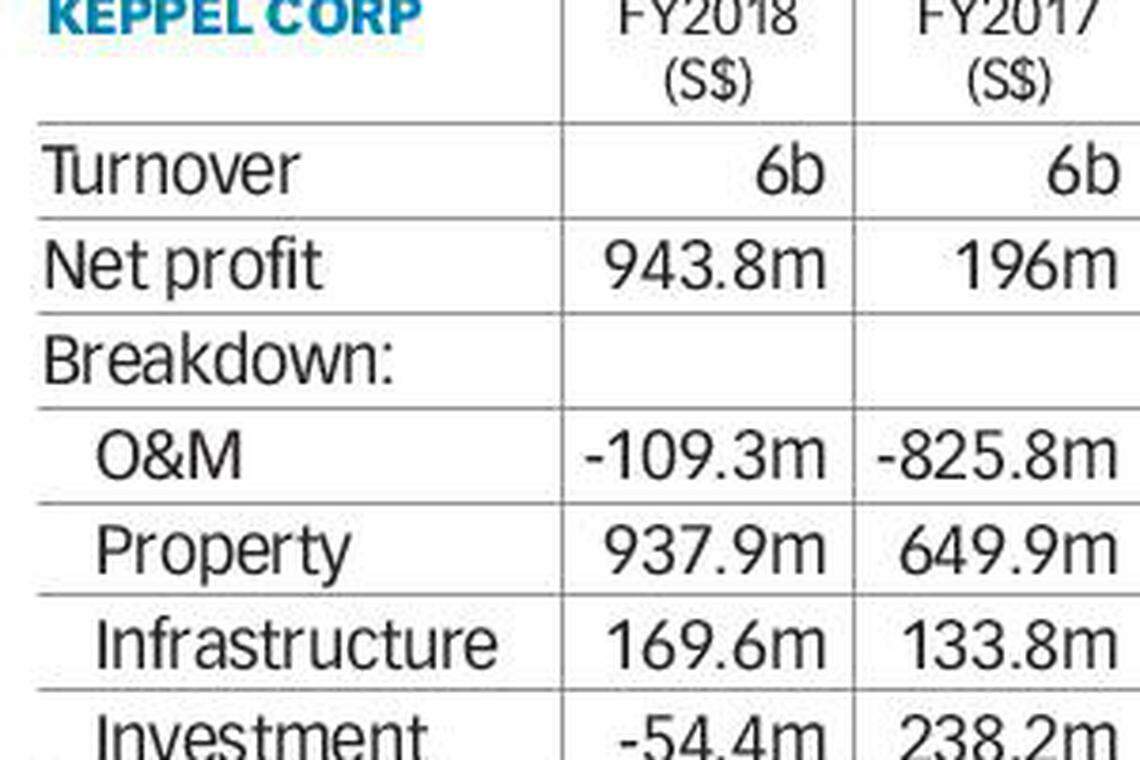Keppel, Sembcorp reinvention - from rigs to urban solutions

Singapore
THEY are both world leaders in the offshore and marine engineering space, but over the past five years, home-grown Keppel Corp and Sembcorp Industries have embarked on bold strategies that have transformed them beyond building rigs for ultra-harsh sea conditions and into sustainable urban solutions providers.
As recently as 2014, offshore and marine (O&M) was their biggest earnings contributor; but today O&M no longer takes the driver's seat.
Grasping for growth, the chiefs of both conglomerates have chosen different paths, yet each reflects where governments in Singapore and the rest of the world see the future - sustainable urbanisation.
Last year, Keppel generated S$943.8 million in net profit. O&M operations incurred a net loss of S$109.3 million; property a net profit of S$937.9 million, infrastructure a net profit of S$169.6 million and investments a net loss of S$54.4 million.
For Sembcorp, it made a net profit of S$347 million. Marine suffered a S$48 million net loss; utilities a net profit of S$312 million, urban development a net profit of S$86 million, while others a net loss of S$3 million.
"The two have made quite a transformation where in 2014, when O&M was the biggest earnings contributor, to the present where they are in a unique position to be able to invest in large infrastructure-related projects that are difficult for investors to invest directly in,'' noted Joel Ng, an investment analyst with KGI Securities Singapore.
"Compared to the past when they waited for order wins, they have now developed their value chain proposition,'' he said.
Since 2015, neither Keppel nor Sembcorp has received any new orders for jackup rigs - a mobile drilling unit anchored to and elevated above the ocean floor by extendable legs.
"With those drying up, the over-capacity in the industry and low crude oil prices, the two groups had to re-position themselves,'' Mr Ng said.
Keppel's chief executive officer, Loh Chin Hua, said Keppel today is more than just an O&M or property business. He wants to unlock Keppel's "ecosystem of companies, working together to provide solutions for sustainable urbanisation".
The group spent the past five years rightsizing and integrating Keppel Offshore & Marine's operating units, repositioning the division to capture new opportunities in the gas, production and non-drilling sectors amid the offshore sector downturn. In 2018, Keppel O&M secured S$1.7 billion worth of new orders, up from S$1.2 billion in 2017. Liquefied natural gas (LNG) and scrubber projects contributed over S$600 million to new orders won last year.

Keppel Land has evolved into a multi-faceted property company. Its asset management businesses have been restructured under Keppel Capital which now has S$29 billion in total AUM as at end-2018.
It also strengthened its data centres and logistics businesses, including setting up UrbanFox - Keppel Telecommunications & Transportation's (Keppel T&T) omnichannel logistics and channel solutions provider - to extend its capabilities into the business-to-consumer (B2C) market. It is in this B2C space that Keppel sees its investment in mobile operator, M1, playing a bigger role, giving the group access to a wider consumer market and allowing it to offer services through a common digital platform. Already, Keppel Electric and M1 have been working together to bundle their power and mobile services for consumers, but more synergies are expected to be harnessed.
"We have worked hard in the last few years to rally our different businesses around the common purpose of providing solutions for sustainable urbanisation, and encouraging them to hunt as a pack for opportunities,'' Mr Loh said in a CEO interview featured in Keppel's 2018 Annual Report.
"... we are further simplifying our corporate structure. This gives us better control of the group's key business verticals, and the flexibility to allocate capital more efficiently towards investments with the best risk-adjusted returns,'' Mr Loh said.
The strategy seems to resonate well with analysts, who like Keppel's ability to leverage more on inter-company collaboration, and share critical functions like finance, IT, and human resources, which they believe give the group a competitive edge in securing huge projects.
Such an example is Keppel T&T's collaboration with Keppel O&M on a concept for floating data centre parks that utilise water for cooling, as well as exploring opportunities with Keppel Electric to offer bundled power solutions to its data centre customers in Singapore. Another is the idea of business "horizontals" like Keppel Capital providing funding platforms with co-investors, allowing the group to seize growth opportunities across chosen sectors, while generating recurring fee income.
"This ability to raise capital and fund projects which they are constructing, and to have integrated projects they develop utilise its range of solutions and services is a very unique proposition,'' said one analyst.
Keppel is "actively exploring and investing" in new businesses such as senior living and renewable energy infrastructure, as well as expanding its presence in B2C businesses including electricity retail and urban logistics.
Mr Loh reckoned that while some of the industries that Keppel operates in are cyclical, sustainable urbanisation and the solutions that the group provides will enjoy many decades of secular growth.
"Our long-term goal is to have each key division contribute no more than 40 per cent of the group's annual net profit, thus moderating our exposure to business-cycle risks," he shared.
Over at Sembcorp, the group has been busy reshaping and securing the right capabilities for the future. Led by CEO Neil McGregor and chairman Ang Kong Hua, Sembcorp has turned to two new growth engines - utilities and urban development - to add to its resilience as the group rides out the protracted marine downturn .
In Sembcorp's 2018 Annual Report, Mr McGregor and Mr Ang, warned: "Building competitive businesses that are attuned to industry trends and well-positioned to thrive amid the global energy transition will take time."
The group is now slightly over a year into its transformation journey. It has brought in new expertise to build a "more competitive, more progressive" group. It sought to grow its renewables business, enter the distributed energy market and strengthen its merchant and retail business, as well as explore potential synergies and combined business opportunities for its energy, marine and urban development businesses, such as in renewables and downstream gas supply.
In Singapore, Sembcorp extended its gas business to include liquefied natural gas imports. It also entered the city-state's recently-launched Open Electricity Market as a power retailer as well as expanded its solar power and renewable energy solutions. It also expanded its renewable energy portfolio footprints in India and the UK.
All these done while its marine business is positioning itself for the future with its state-of-the-art Tuas Boulevard Yard, where enhanced capabilities offer the ability to serve new customer segments. The business has invested in new technologies such as floating cylindrical units for offshore application, and entered the market for renewable energy engineering projects.
On rumours of possible merger between Sembcorp's yards and Keppel O&M, one analyst said: "Not a merger. I believe it makes more sense for Sembcorp to make a bid to privatise Sembcorp Marine soon,'' he said.
BT is now on Telegram!
For daily updates on weekdays and specially selected content for the weekend. Subscribe to t.me/BizTimes
Companies & Markets
Frasers Centrepoint Trust posts 1.8% drop in H1 DPU to S$0.06022
TSMC says ‘A16’ chipmaking tech to arrive in 2026, setting up showdown with Intel
US seeks 36 months’ jail for Binance founder Zhao
Keppel’s Q1 revenue down 6.3% to S$1.5 billion; net profit up with exclusion of legacy O&M assets
Cisco says hackers subverted its security devices to spy on governments
Stocks to watch: Keppel, FCT, Suntec Reit, OUE Reit, Clint, Digital Core Reit, OKP, Cordlife
